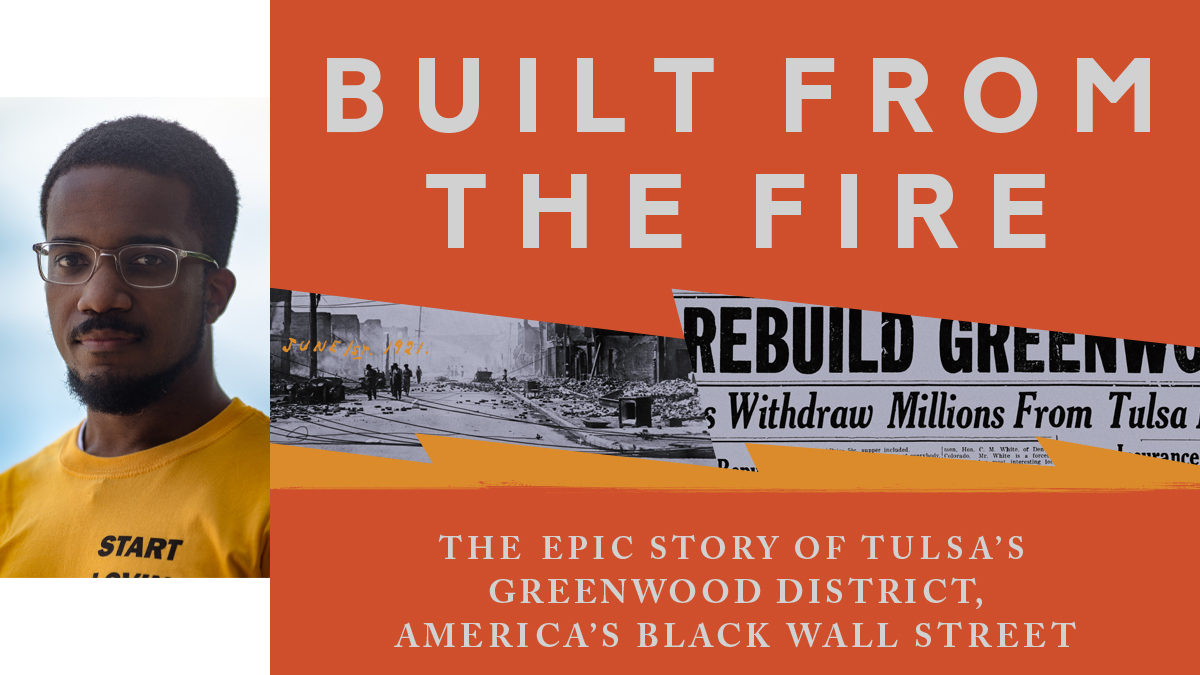
Victor Luckerson in conversation with Ralph Eubanks for Built From the Fire

In the past decade, Black Wall Street and the Tulsa Race Massacre have entered the public consciousness and national dialogue where it had previously been absent: a plotline in several popular television shows, the subject of numerous books, documentaries, and television specials. And despite this increased awareness, we have gotten the story wrong, our gaze into the past all too American in its nature: fixated on the violent act itself rather than the century-long struggle for equality that ensued. It is a tragedy and a horror but it’s also a story of unimaginable resilience and fortitude.
In National Magazine Award–finalist Victor Luckerson’s essential new book, Built from the Fire: The Epic Story of Tulsa’s Greenwood District, America’s Black Wall Street (Random House; Hardcover), Luckerson moves beyond the mythology of Black Wall Street to tell the story of an aspirant black neighborhood that, like so many others, has long been buffeted by racist government policies. Through the eyes of dozens of race massacre survivors and their descendants, Luckerson delivers an honest, moving portrait of this potent national symbol of success and solidarity—and weaves an epic tale about a neighborhood that refused, more than once, to be erased.
The story of Greenwood did not end on June 1, 1921, though the mob certainly wanted it that way. Days after a group of more than a thousand white assailants leveled more than 1,200 houses, burned to the ground nearly every business, and killed as many as 300 people, the survivors of the Tulsa race massacre were already rebuilding. A barber set up a chair in the middle of Greenwood Avenue and got back to plying his trade; so did a pair of neighborhood lawyers, bent on protecting citizens from further wrongs. The formerly opulent Dreamland Theater no longer had a roof, but that did not stop it from screening films on muggy summer nights. And a couple named J.H. and Carlie Goodwin began rebuilding their Greenwood Avenue office building even as white city leaders were plotting to relocate black people out of sight and out of mind. The tiny little Greenwood district of Tulsa, Oklahoma—admired by both Booker T. Washington and W.E.B. Du Bois, visited by Etta James and Muhammad Ali, mythologized by HBO’s Watchmen—held its own, no matter how massive the challenges.
In the decades after 1921, survivors and descendants continued to fight for Greenwood, and few have fought harder than the Goodwin family. Through the generations, they have battled in the newsroom, the courtroom, and even the state Capitol in their pursuit of justice. Massacre survivor Ed Goodwin became the publisher of the Oklahoma Eagle, the now-101-year-old Black newspaper in the heart of the Greenwood district. His son Jim, a civil rights attorney, now runs the paper; his granddaughter Regina represents Greenwood in the Oklahoma House of Representatives. The Goodwins and their neighbors have weathered like hailstorms everything from redlining policies codified in the 1930s to urban renewal plans executed in the ‘60s to the cases of police brutality that were crystallized by the murder of George Floyd but had been protested in Tulsa long before then. They have been here, doing the work. But as a country we still haven’t grappled with this iconic neighborhood’s full story.
If we truly want to understand the causes of an eventlike the one in 1921, and what happens to a community in its wake, we must understand Greenwood and the citizens who have fought for it for a century. Built from the Fire’s beating heart are the families that, generation after generation, insisted on seizing control of their own story. Luckerson has written about Tulsa’s historically Black Greenwood district multiple times for The New Yorker, The Ringer, and Smithsonian Magazine. His experiences reporting those pieces and his introduction to the Goodwins, an influential, entrepreneurial Black family based in Greenwood for five generations, led him to move to Tulsa in 2019. BUILT FROM THE FIRE is the result of four years of on-the-ground research and hundreds of interviews—a century-spanning deep dive following one family in a neighborhood most Americans only know about glancingly, due to a particularly tragic event in its past.



